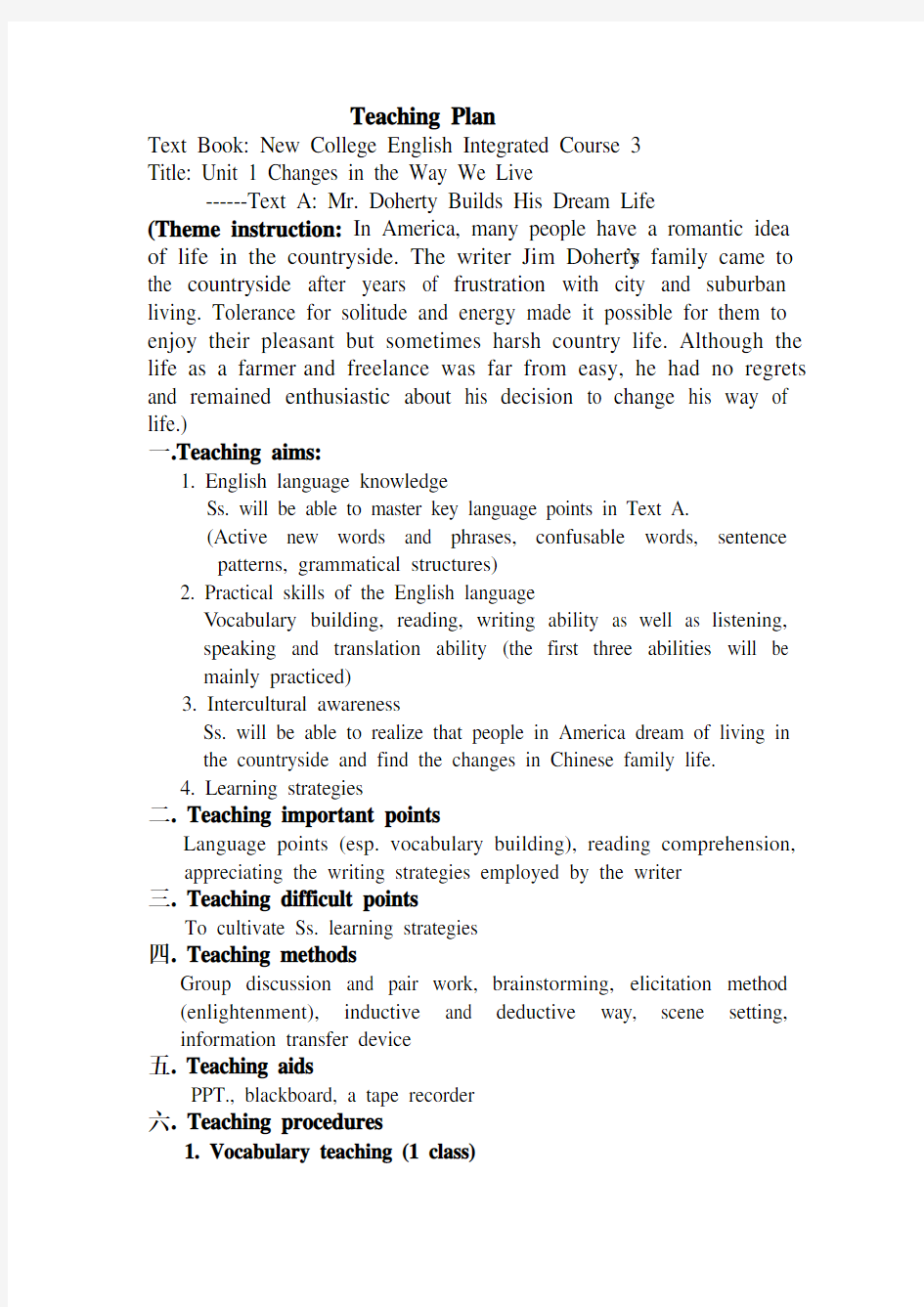Unit 1 Changes in the Way We Live(教案)


T eaching Plan
Text Book: New College English Integrated Course 3
Title: Unit 1 Changes in the W ay W e Live
------Text A: Mr. Doherty Builds His Dream Life
(Theme instruction: In America, many people have a romantic idea of life in the countryside. The writer Jim Doherty’s family came to the countryside after years of frustration with city and suburban living. Tolerance for solitude and energy made it possible for them to enjoy their pleasant but sometimes harsh country life. Although the life as a farmer and freelance was far from easy, he had no regrets and remained enthusiastic about his decision to change his way of life.)
一.T eaching aims:
1. English language knowledge
Ss. will be able to master key language points in Text A.
(Active new words and phrases, confusable words, sentence
patterns, grammatical structures)
2. Practical skills of the English language
V ocabulary building, reading, writing ability as well as listening, speaking and translation ability (the first three abilities will be mainly practiced)
3. Intercultural awareness
Ss. will be able to realize that people in America dream of living in the countryside and find the changes in Chinese family life.
4. Learning strategies
二. T eaching important points
Language points (esp. vocabulary building), reading comprehension, appreciating the writing strategies employed by the writer
三. T eaching difficult points
To cultivate Ss. learning strategies
四. T eaching methods
Group discussion and pair work, brainstorming, elicitation method (enlightenment), inductive and deductive way, scene setting, information transfer device
五. T eaching aids
PPT., blackboard, a tape recorder
六. T eaching procedures
1. V ocabulary teaching (1 class)
(1) In sentence context (words, expressions and their collocations)
(2)Association (classroom brainstorming: synonyms, words related
to one topic, etc.)
(3) Confusable words distinguishing
(4) Prefix, suffix
(5)Conversion (newly introduced in this Unit)
2. Reading class (T ext A) (4 classes)
Pre-reading (Lead-in)
(Purpose: to get Ss. familiarized with the topic of Text A and arouse their interest in the following study of Text A)
Setting a scene: (getting Ss. familiarized with the cultural background knowledge relevant to Text A)
While-reading (How to comprehend)
(1)Skimming: (reading fast to get the gist; reading the first sentence
of each paragraph to sum up the main idea of each part)
①To give Ss. the division of Text A and the main idea of each
part but in wrong order;
②To let Ss. read Text A quickly to match the main ideas with
divided parts in right order
(2)Scanning: (reading fast to find specific information and
information transfer activity with information transfer device)
To let Ss. read through Text A and make a list of the happy moments and events as well as the hardships in the following
(3)Reading comprehension questions:
①Question for reorganization (main idea)
②Question for inference (author’s attitude)
(4)Language points study (while guiding Ss. to read along each part in Text A)
①Analyzing long and complex sentences (students’ initiative)
②Grammar involved(in a systematic teaching way: by contrast, etc.)
③After-text exercises in the part of Language Focus (methods given:
context, grammar, collocation)
Post-reading
(purpose: to let Ss. produce language based on what they have learned, ie, output and integrating process)
(1)To demonstrate an essay writing process: (inductive way)
①Brainstorming: Changes in Chinese family life today and
yesterday;
②To explain the writing strategy newly introduced in this unit:
comparison and contrast (writing an insightful concluding
remark, using transitional words and phrases)
(2)Appreciation (deductive way)
①To let Ss. reread some paragraphs in Text A and guide them to
appreciate the techniques employed by the writer (Ss.’
initiative)
Topic sentences followed by detailed sentences (Parallelism
among detailed sentences);
Use of transitional devices
②To let Ss. write an essay with these writing strategies Homework
①Learning Text B by Ss. themselves
②To preview Unit 2 Text A (especially, vocabulary)
